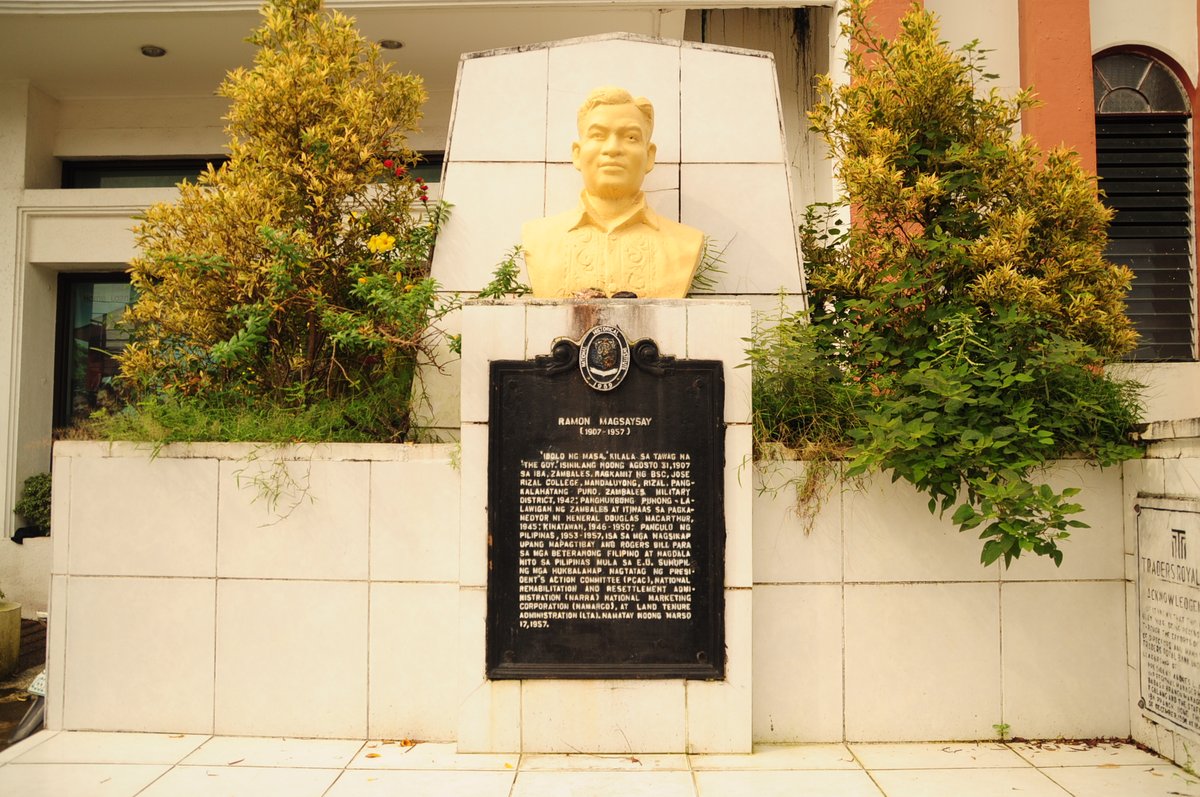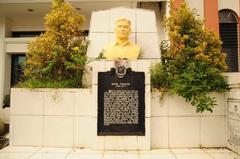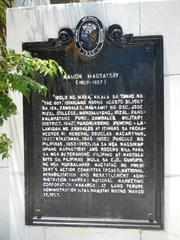
Ramon Magsaysay Historical Marker: Visiting Hours, Tickets, and Comprehensive Guide – Castillejos, Zambales, Philippines
Date: 14/06/2025
Introduction
The Ramon Magsaysay Historical Marker and Ancestral House in Castillejos, Zambales, is a cornerstone of Philippine heritage. Honoring the country’s seventh president—Ramon del Fierro Magsaysay, revered as “The Guy” and the “Champion of the Masses”—the site offers profound insight into values of integrity, public service, and grassroots leadership. This extensively curated guide covers the historical significance of the marker and museum, practical visiting information, accessibility, local events, and travel tips, making it an essential resource for history enthusiasts, students, and travelers aiming to explore one of the most important Zambales historical sites.
Located in Barangay Sta. Maria, the marker and museum occupy the grounds of Magsaysay’s childhood home, near the location of his tragic death in 1957. The site has been preserved and restored by the National Historical Commission of the Philippines (NHCP), blending early 20th-century Filipino architecture with modern museum standards. Visitors can expect to see personal artifacts, archival documents, and multimedia exhibits—including a 360-degree VR experience—that vividly recount Magsaysay’s life and enduring legacy.
For those planning a visit, this guide includes up-to-date details on visiting hours, free admission, accessibility features, transportation, nearby attractions, and seasonal events. Key terms like “Ramon Magsaysay visiting hours,” “Ramon Magsaysay tickets,” and “Castillejos historical sites” are integrated throughout for easy information retrieval. For further details, consult the NHCP official website or the Ranger Cabunzky Blogspot, and consider downloading the Audiala app for enhanced onsite experiences.
Historical Overview
Early Life and Family Background
President Ramon Magsaysay was born on August 31, 1907, in Iba, Zambales, to Exequiel Magsaysay and Perfecta del Fierro. The family later settled in Castillejos, where their ancestral house—now the historical marker and museum—reflects their humble roots (Ranger Cabunzky Blogspot). Growing up in rural Zambales, Magsaysay developed a strong sense of community and hard work that would define his public service.
Education and Early Career
Magsaysay briefly attended the University of the Philippines before transferring to José Rizal College (now José Rizal University), where he graduated with a commerce degree in 1932. He worked as a mechanic and chauffeur, experiences that shaped his empathy for ordinary Filipinos (Official Gazette).
Wartime Service and Political Rise
During World War II, Magsaysay led guerrilla forces in Zambales against Japanese occupation, earning a reputation for bravery and integrity (NHCP). After the war, he entered politics, serving as a congressman focused on rural development and veterans’ welfare. As Secretary of National Defense (1950), he became nationally prominent for his campaign against the Hukbalahap insurgency (Official Gazette).
Presidency (1953–1957) and Key Achievements
Elected in 1953, Magsaysay’s presidency is remembered for restoring faith in democracy and implementing reforms:
- Land Reform: Championed the Agricultural Tenancy Act of 1954.
- Anti-Corruption: Established the Presidential Complaints and Action Committee (PCAC), processing thousands of public grievances (Official Gazette).
- Rural Development: Prioritized infrastructure like roads, bridges, and irrigation.
- National Defense: Successfully dismantled the Hukbalahap movement, restoring peace in rural areas.
His accessible, humble leadership style set a standard for public service (NHCP).
Legacy and National Recognition
Magsaysay’s influence endures through the Ramon Magsaysay Award Foundation, which annually honors individuals and organizations across Asia for integrity and service—often called “Asia’s Nobel Prize.” The ancestral house and marker in Castillejos serve as living classrooms for civic values and heritage education (Ranger Cabunzky Blogspot).
Visiting the Ramon Magsaysay Historical Marker and Ancestral House
Location and Directions
- Address: Barangay Sta. Maria, Castillejos, Zambales, Philippines
- Accessibility: 150 km northwest of Metro Manila, accessible via bus (Victory Liner, Saulog Transit) or private car (SCTEX and Olongapo-Bugallon Road). Local tricycles provide last-mile connectivity (Victory Liner Routes).
Visiting Hours
- Ancestral House Museum: Tuesday–Sunday, 8:00 AM–5:00 PM; closed Mondays and public holidays.
- Historical Marker: Open-air site accessible 24/7, but best visited during daylight for safety and better appreciation.
Ticketing
- Admission: Free for both the marker and museum. Donations for conservation are welcome but not required.
Facilities and Accessibility
- Museum: Partially wheelchair accessible; ramps at entrance but some areas may be difficult due to historic architecture. Staff are available to assist.
- Marker Plaza: Landscaped with benches and shaded areas; roadside parking available.
- Amenities: Restrooms and eateries are in Castillejos town proper (~2 km away). Bring water and sun protection.
Guided Tours and Special Events
- Guided Tours: Available by appointment; recommended for groups and school visits.
- Special Events: Annually, the Suman Ibos Festival in March commemorates Magsaysay’s legacy with parades, culinary contests, and cultural performances (PeoPlaid).
Exhibits, Features, and Interactive Experiences
Museum Galleries
- Gallery Themes: The Life of Magsaysay, Magsaysay’s Family, Death & Legacy.
- Highlights: Personal artifacts (barong Tagalog, medals), family photographs, presidential car, memorabilia, vintage telegrams from Carlos P. Romulo and Richard Nixon, and multimedia presentations (Audiala).
- VR Experience: 360-degree NHCP-produced exhibit immerses visitors in pivotal moments of Magsaysay’s life.
Historical Marker
- Design: Bronze plaque on stone pedestal, inscribed in Filipino, set in a tranquil landscaped plaza.
- Interpretation Panels: Bilingual information describing Magsaysay’s achievements and the 1957 plane crash.
Community and Cultural Importance
Educational Programs
- School Integration: Magsaysay’s story is part of the curriculum, with field trips and educational workshops at the site.
- Civic Engagement: The site hosts essay contests, art competitions, and storytelling sessions to instill civic values.
Community Events
- Annual Commemorations: Wreath-laying and ceremonies on Magsaysay’s birth and death anniversaries.
- Local Involvement: Residents participate in upkeep and guide visitors, reflecting pride in their heritage.
Practical Travel Tips
- Best Time to Visit: Dry season (December–February) for cooler weather and minimal rainfall (PAGASA Climate Data).
- What to Bring: Sun protection, water, cash (local establishments may not accept cards).
- Safety: Castillejos is a safe municipality; practice standard precautions, especially during crowded events.
Transportation
- By Bus: Direct buses from Manila to Castillejos; ~3–4 hours travel time.
- By Car: Via SCTEX and Olongapo-Bugallon Road; ~2.5–3 hours from Manila.
- Local Transport: Tricycles and jeepneys are widely available.
Nearby Attractions
- Carmelite Monastery and Sta. Maria Parish Church: Notable Castillejos historical sites (PeoPlaid).
- Subic Bay Freeport Zone: Beaches, shopping, and adventure parks (Subic Bay Tourism).
- Botolan Wildlife Farm: Native flora and fauna (Botolan Wildlife Farm).
- San Marcelino Church: Spanish-era architecture nearby.
Accessibility for Persons with Disabilities
While the museum offers ramps at the entrance, some areas remain difficult for wheelchair users due to the ancestral house’s historic architecture. The marker plaza is mostly level but unpaved; assistance is recommended for those with mobility challenges (Castillejos LGU Announcements).
Frequently Asked Questions (FAQs)
Q: Are there entrance fees or tickets?
A: Admission to both the marker and museum is free.
Q: What are the visiting hours?
A: Marker is open 24/7; museum is open Tuesday–Sunday, 8:00 AM–5:00 PM.
Q: Is the site accessible for persons with disabilities?
A: Partially accessible; ramps at the museum entrance, but some areas may be challenging.
Q: Are guided tours available?
A: Yes, by appointment with the local tourism office or museum staff.
Q: Where can I park?
A: Roadside parking is available near the site.
Q: What is the best time to visit?
A: December–February during the dry, cooler season.
Summary & Encouragement to Visit
The Ramon Magsaysay Historical Marker and Ancestral House Museum in Castillejos offer meaningful opportunities to engage with Philippine history, honor a legacy of public service, and reflect on enduring values of democracy and good governance. With free admission, curated exhibits, and a welcoming local community, the site is a must-visit for travelers and students alike. Plan your trip during the dry season, combine your visit with nearby attractions, and participate in local festivals for a richer experience. For updates and enhanced tours, download the Audiala app and follow official social media channels (National Historical Commission of the Philippines, Ranger Cabunzky Blogspot).
Official Sources and More Information
- Ranger Cabunzky Blogspot: President Ramon Magsaysay’s Ancestral House
- National Historical Commission of the Philippines – Ramon Magsaysay
- Official Gazette: Inaugural Address of President Magsaysay
- Philippine Companies: President Ramon Magsaysay Historical Landmark, Castillejos
- Nomadic Experiences: The Ramon Magsaysay Museum & Ancestral House
- Vigattin Tourism: The Magsaysay Ancestral House
- PeoPlaid: Castillejos Historical Sites
- Audiala: Ramon Magsaysay Museum & Historical Marker
- Castillejos Local Government Facebook Page
- Victory Liner: Bus Routes
- PAGASA: Climate Data
- Subic Bay Tourism
- Botolan Wildlife Farm
For a seamless experience, download the Audiala app for maps, guided tours, and exclusive content about Philippine historical sites.

